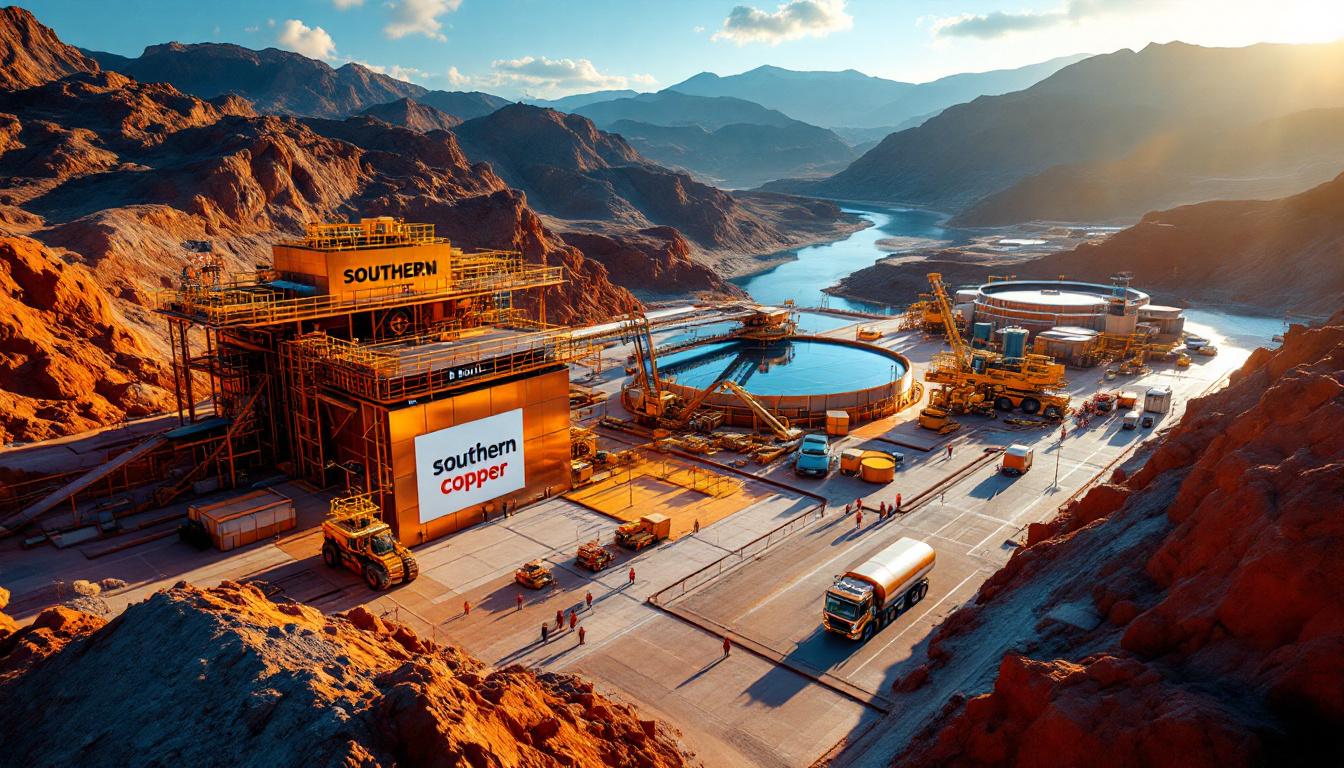How Are Climate Models Helping Queensland's Mining Industry?
Advanced Climate Modeling for Mining Risk Assessment
The Sustainable Minerals Institute (SMI) at The University of Queensland has developed groundbreaking predictive tools that map potential climate change impacts specifically for Queensland's mining regions. Using state-of-the-art climate projections from the Queensland Future Climate Science Program, researchers have created the first comprehensive mapping system showing how key mining areas might be affected by changing climate conditions over the coming decades.
These advanced models represent a significant leap forward in predicting physical climate change impacts on Queensland's mining sector, allowing companies to visualize potential challenges decades in advance.
"Our modeling integrates complex climate data sets with mining-specific vulnerabilities to create actionable intelligence for the industry," explains Dr. Nevenka Bulovic, SMI Research Fellow leading the project.
Key Climate Risk Factors Identified
The new predictive tool focuses on three critical climate risk factors that directly impact mining operations:
- Erosion risk changes across mining landscapes, which threaten infrastructure stability and rehabilitation efforts
- Drought frequency and intensity patterns that affect water availability for processing and dust suppression
- Extreme rainfall events and flooding potential that can disrupt operations and damage critical infrastructure
These factors were selected based on their significant operational and financial implications for mining activities, infrastructure stability, and environmental management requirements. The tool's high-resolution mapping capability allows companies to assess these risks at specific site locations rather than relying on broader regional assessments.
Why Is Climate Risk Assessment Critical for Mining Operations?
United Nations Recognition of Mining Vulnerability
The United Nations has specifically identified climate change as a primary physical and financial risk factor for the global mining sector in their 2024 report "Climate Risks in the Metals and Mining Sector". This assessment underscores the importance of developing region-specific predictive tools that can help mining operations prepare for and mitigate climate-related disruptions.
According to the report, mining operations worldwide face up to $100 billion in climate-related risks by 2040 if adaptation measures aren't implemented.
Long-Term Climate Impact Persistence
Even with rapid global decarbonization efforts, climate change impacts will continue for decades or longer. Dr. Nevenka Bulovic, SMI Research Fellow, emphasizes that "The impacts will go on for decades and possibly longer, so we need to make sure that the expanding mining sector and its stakeholders are prepared for the higher climate change risks they will face in the future."
This persistence creates a unique challenge for mining operations, which typically have multi-decade lifecycles from exploration through closure and rehabilitation.
Financial and Operational Implications
Climate change presents multiple interconnected challenges for mining operations:
- Increased infrastructure damage from extreme weather events, with tailings facilities especially vulnerable
- Water management complications during both drought and flood conditions, affecting processing efficiency
- Supply chain disruptions affecting operational continuity and equipment availability
- Higher remediation and adaptation costs, potentially adding 15-25% to operational budgets
- Potential regulatory changes requiring new operational approaches and reporting
Queensland's mining operations, particularly in the northern regions, have already experienced the financial impact of these challenges, with the 2019 floods causing over $2 billion in production losses across the sector.
What Does the New Climate Risk Assessment Tool Offer?
Screening Capabilities for Stakeholders
The tool serves as an essential screening mechanism for various stakeholders in the mining sector:
- Mining companies conducting risk assessments for current and future operations, including site selection
- Government agencies developing regional adaptation policies and infrastructure planning
- Investors evaluating climate-related financial risks and performing due diligence
- Technical advisors designing climate-resilient infrastructure and operational protocols
- Communities in mining regions preparing for changing conditions and evaluating proposed projects
This multi-stakeholder approach creates a common baseline for climate risk discussions, enabling more informed decision-making across the sector.
Enhanced Climate Literacy in Mining
Beyond providing data, the tool aims to improve overall climate literacy within the mining sector. This educational component helps decision-makers better understand:
- How climate projections are developed and interpreted, including confidence levels
- The relationships between different climate variables and mining operations
- Appropriate timeframes for considering different climate risks (near-term vs. long-term)
- Uncertainty factors in climate projections and how to account for them in planning
"We've designed the tool to demystify climate science for mining professionals," notes Dr. Bulovic. "Understanding the underlying science is crucial for effective adaptation planning."
Visualization and Accessibility Features
The tool transforms complex climate data into accessible formats through:
- Interactive maps showing projected changes across Queensland with filtering options
- Timeline visualizations demonstrating progressive climate impacts through 2100
- Comparison features allowing assessment across different climate scenarios (RCP4.5, RCP8.5)
- Downloadable data for integration with company-specific risk models and planning tools
These visualization capabilities allow non-technical users to quickly grasp complex climate projections and their potential impacts on specific mining operations.
How Was This Predictive Tool Developed?
Multidisciplinary Collaboration
The development process brought together experts from diverse fields:
- Hydroclimate scientists from Queensland Treasury providing modeling expertise
- Mining sustainability specialists from SMI contributing operational context
- Climate projection experts from the Queensland government ensuring scientific rigor
- Industry representatives providing operational context and practical applications
Dr. Ralph Trancoso, Science Leader of Climate Projections & Services at Queensland Treasury, highlighted Dr. Bulovic's "unique skillset with expertise in both hydroclimate science and mining sustainability" as critical to addressing knowledge gaps at the intersection of these fields.
This collaboration ensured the tool balanced scientific accuracy with practical utility for the mining sector.
Funding and Support Structure
The project received financial and technical support from multiple sources:
- SMI's Resourcing Decarbonisation strategic program providing research leadership
- Queensland government climate initiatives contributing data and technical expertise
- International Council on Mining and Metals (ICMM) offering industry guidance
- Queensland Government's Climate Projections and Services team supplying modeling resources
This diverse funding approach ensured the tool's development incorporated perspectives from research, government, and industry stakeholders, creating a more robust and widely applicable resource.
What Climate Adaptation Strategies Can Mining Companies Implement?
Infrastructure Resilience Planning
Mining operations can enhance their climate resilience through:
- Designing water management systems for more extreme rainfall events (up to 25% intensity increase)
- Strengthening tailings dams and waste facilities against erosion under new precipitation patterns
- Implementing redundant systems for critical infrastructure like power and water supply
- Developing flexible operational protocols for extreme weather conditions and recovery
"The most cost-effective adaptation approach is incorporating climate projections into new infrastructure design rather than retrofitting," notes mining engineer James Wilson of Resource Resilience Consulting. "Our analysis shows a 3:1 return on investment for proactive resilience planning."
Water Management Optimization
As water availability patterns change, mining companies should consider:
- Diversifying water sources to reduce dependency on climate-sensitive supplies
- Implementing advanced water recycling and efficiency technologies to reduce overall demand
- Developing drought contingency plans for extended dry periods, including operational modifications
- Creating excess capacity for managing intense rainfall events with robust containment systems
Water-related disruptions already cost Queensland's mining sector approximately $120 million annually, a figure projected to increase by 40% by 2040 without adaptive measures.
Supply Chain Risk Mitigation
Climate disruptions often affect supply chains, requiring:
- Strategic stockpiling of critical materials and components based on vulnerability assessment
- Development of alternative transportation routes and methods for extreme weather conditions
- Collaborative planning with suppliers and logistics providers to identify and address vulnerabilities
- Regular climate risk assessments throughout the supply network to identify emerging threats
These supply chain adaptations are particularly important for remote mining operations in Queensland's interior, where access routes may be limited and vulnerable to disruption.
How Will Climate Change Specifically Impact Queensland's Mining Regions?
Regional Vulnerability Variations
The tool reveals significant differences in climate vulnerability across Queensland's diverse mining regions:
- Coastal mining areas (e.g., Gladstone) face increased tropical cyclone intensity and sea level impacts, potentially affecting port infrastructure and shipping
- Inland operations (e.g., Bowen Basin) must prepare for more extreme heat (up to 3°C increase by 2050) and drought conditions affecting water availability
- Northern regions (e.g., Cape York) may experience more intense but less frequent rainfall events, creating flash flooding challenges
- Southern areas (e.g., Surat Basin) could see shifts in seasonal rainfall patterns affecting water availability and groundwater recharge
These regional variations highlight the importance of localized climate risk assessment rather than applying broad assumptions across the entire mining sector.
Timeline of Projected Impacts
The assessment tool provides projections across multiple timeframes:
- Near-term impacts (2025-2035) requiring immediate adaptation measures, particularly for water management
- Mid-century projections (2035-2055) for medium-term planning, including infrastructure design and rehabilitation strategies
- Long-range scenarios (beyond 2055) informing major infrastructure decisions and mine closure planning
This temporal approach allows mining operations to develop staged adaptation strategies aligned with asset lifecycles and investment planning, prioritizing immediate vulnerabilities while preparing for longer-term changes.
What Are the Financial Implications of Climate Change for Mining Companies?
Risk Assessment for Investors
The new tool provides valuable information for investors conducting climate risk due diligence:
- Quantitative data on physical climate risks by region, allowing portfolio diversification
- Comparative analysis across different mining operations to identify relative vulnerability
- Scenario-based projections under various climate futures aligned with TCFD reporting requirements
- Integration potential with financial risk assessment frameworks and ESG reporting systems
"Investors now routinely decline projects without robust climate risk disclosures," notes financial analyst Sophia Chen of Climate Capital Analytics. "The quality of climate risk assessment can directly impact financing costs by up to 150 basis points for high-risk projects."
Insurance and Financing Considerations
Climate projections increasingly influence financial aspects of mining operations:
- Rising insurance premiums in high-risk areas, with some locations seeing 30-40% increases
- Lender requirements for climate adaptation planning as part of financing agreements
- Investor expectations for climate risk disclosure in line with emerging global standards
- Potential stranded asset risks for long-life mining operations in highly vulnerable regions
These financial pressures create strong incentives for mining companies to invest in climate resilience and incorporate adaptation strategies into their operational planning and investment decisions.
Risk Management Insight:
Mining companies that proactively adapt to climate risks often see competitive advantages beyond just risk reduction. Enhanced water efficiency, for example, can lower operational costs while simultaneously reducing climate vulnerability.
How Does This Tool Support Regulatory Compliance?
Alignment with Emerging Reporting Requirements
The predictive tool helps mining companies meet evolving regulatory expectations:
- Task Force on Climate-related Financial Disclosures (TCFD) reporting requirements becoming mandatory in many jurisdictions
- Environmental impact assessment requirements under Queensland's Environmental Protection Act amendments
- Mining license conditions related to climate resilience and emergency response planning
- Community engagement obligations regarding climate risks and adaptation measures
As regulatory frameworks evolve, having standardized climate projections provides mining companies with defensible data for compliance reporting and stakeholder communications.
Proactive Risk Management
By incorporating climate projections into planning, mining companies can:
- Demonstrate due diligence to regulators and stakeholders, potentially streamlining approvals
- Reduce potential liability from climate-related incidents through documented risk assessment
- Support applications for new projects with robust climate considerations and adaptation plans
- Participate more effectively in regional adaptation planning with communities and government
This proactive approach can transform climate risk management from a compliance burden to a strategic advantage in regulatory engagement and community relations.
What's Next for Climate Risk Assessment in Mining?
Tool Availability and Implementation
The climate risk assessment tool will be publicly available by July 2025 through the Queensland Government's Long Paddock website. This accessibility ensures that:
- Companies of all sizes can incorporate climate projections into planning, not just those with extensive resources
- Consistent data is available across the sector for comparative analysis and benchmarking
- Regional planning can incorporate mining-specific climate considerations for infrastructure development
- Research and innovation can build upon standardized projections to develop new adaptation technologies
"Making this tool freely available democratizes climate risk assessment across the sector," explains Dr. Bulovic. "Small and medium mining enterprises can now access the same quality projections as the majors."
Future Research Directions
The development of this tool opens pathways for additional research:
- Integration with economic models to quantify financial impacts under different adaptation scenarios
- Expansion to cover additional climate variables relevant to mining, such as groundwater impacts
- Application of similar methodologies to other mining regions globally, creating comparative datasets
- Development of specific adaptation technologies for high-risk operations in vulnerable regions
These research directions highlight the evolving nature of climate risk assessment in the mining sector, with ongoing refinement and expansion of capabilities expected as climate science advances.
FAQ: Climate Change and Queensland Mining
How accurate are climate projections for specific mining regions?
Regional climate projections have significantly improved in recent years, with Queensland's models now operating at high spatial resolution (10km grid cells). While uncertainty remains, particularly for precipitation patterns, the projections provide robust directional guidance for risk assessment and adaptation planning. The Queensland Future Climate projections achieve 80-95% accuracy for temperature trends and 65-80% for precipitation patterns over 20-year periods.
What climate factors pose the greatest risks to mining operations?
Water-related impacts—including both drought and flooding—typically present the most immediate operational challenges. However, rising temperatures also affect worker health and safety, equipment performance, and energy transition strategies for cooling and ventilation systems. The most costly disruptions generally stem from extreme rainfall events that exceed drainage system capacity or trigger landslides affecting access routes.
How can smaller mining companies access and utilize climate risk data?
The public availability of this tool ensures that companies of all sizes can access sophisticated climate projections without needing extensive in-house climate expertise. The tool's user-friendly interface and educational components make it accessible for smaller operations with limited resources for climate risk assessment. Additionally, industry associations like the Queensland Resources Council offer workshops to help smaller operators interpret and apply the climate data to their specific operations.
What role does climate adaptation play in mine closure planning?
Climate projections are increasingly important for mine closure and rehabilitation planning, as changing conditions may affect revegetation success, erosion control, and long-term stability of rehabilitated landscapes. The tool can help companies design closure plans that remain effective under future climate conditions, potentially reducing long-term liability and maintenance costs. Successful rehabilitation under changing climate conditions typically requires more diverse plant species selection and more robust natural capital in mining approaches than historical methods.
Further Exploration:
Readers interested in learning more about climate resilience in the mining sector can explore related educational content available through the Queensland Government's Future Climate website, which provides additional resources on climate projections and adaptation planning for various industries including electrification in mining and carbon sequestration technology.
Ready to Discover Australia's Next Major Mining Opportunity?
Stay ahead in the mining investment game with Discovery Alert's proprietary Discovery IQ model, delivering real-time notifications when significant mineral discoveries are announced on the ASX. Explore our dedicated discoveries page to understand how early investors in major mineral finds have achieved exceptional returns.




